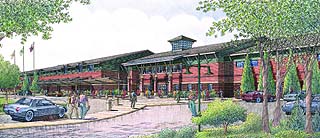
DJC.COM
August 20, 2002
Mount Tahoma High plans to break the scale
Journal Staff Reporter

Courtesy of Burr Lawrence Rising + Bates The 1,800-student Mount Tahoma High School will feature two, two-story general curriculum wings that provide personalized learning environments. The school’s unconventional design is intended to foster better teaching and a sense of belonging.
|
After numerous meetings with a 40-member planning/design committee, architects for the Mount Tahoma High School in Tacoma knew expectations were high.
As a Gates Grant school, the $77 million facility would feature two, two-story general curriculum wings that would provide personalized learning environments.
“The staff and administrative leadership is committed to creating smaller learning communities as a way to improve on the education process,” said Tom Bates, principal in charge at the Tacoma firm Burr Lawrence Rising + Bates. “The new school contemplates that in the design, trying to break down the scale of an 1,800-student high school. The timing of this high school coincides with the re-thinking of how to better deliver education.”
| Project team |
|
Architect
Burr Lawrence Rising + Bates Structural engineer Putnam Collins Scott Associates Mechanical/electrical engineers Hargis Engineers, Inc. Civil engineers AHBL, Inc. Landscape architect Lynn William Horn Associates Acoustical consultant Listen Acoustics |
The most traditional elements of the design are found in the exterior, with durability being the driving force behind the selection of brick, concrete masonry and metal siding. Bates said designers strived to fit the building in its context.
The programming context, however, focuses on four multi-grade-level team areas in the two wings. Each wing has 10 general purpose classrooms, two resource classrooms, one special needs classroom, a staff team room and restrooms.
The 56-acre campus will also include a 3,100-seat stadium, a main gymnasium with 1,800 bleacher seats, auxiliary gym and 25-yard competition swimming pool in a natatorium. The cafeteria will handle 800 students, the performing arts auditorium will hold 400 and the library/media center will house 20,000 books.
The interdisciplinary team areas create schools within schools, Bates said. “What educational reform people tell you is that creating smaller learning environments strengthens relationships and creates a sense of belonging,” he said. “Research says that when you have smaller environments you have a place where kids excel and teachers improve their skills working collaboratively with other teachers. A lot of wonderful things happen when you break down the scale of schools.”
From a sustainable standpoint, Bates said the building allows daylight to penetrate many of the educational areas and uses natural ventilation wherever possible. Earth friendly products with low-volatility compounds and recycled-content products were also selected.
Even the engineering process is innovative. The project’s structural engineers, Putnam Collins Scott Associates, will produce structural design documents prior to the general bid, this November. This will allow the school district to get bids and place a mill order for the project’s structural steel, and the mill order will then be assigned to the successful low bidder/general contractor for the overall construction project.
|
“In general, the purpose of this process is to streamline the ordering and get the structural steel fabricated in a timely manner,” said Burr Lawrence Rising + Bates project manager John Wegener. “The process, called an ‘integrated steel design process,’ developed by PCSA, Inc., has been utilized on many private projects. But to our knowledge this is the first time it will be implemented on a public school project of this scale in the state of Washington.”
City Transfer, Inc. is the general contractor for Phase I of the project, which includes rough grading and preparation of the building construction pads and underground utilities. Phase II is scheduled to go out to bid in October or November of this year. The school will open the fall of 2004.
The $77 million total project cost includes sales taxes, permit fees, A/E fees, moving costs, furniture and equipment and technology equipment. The total maximum allowable construction cost is $56.5 million.
Other Stories:
- Building schools fit to compete
- Green features encourage schools to lighten up
- More funding is needed for school construction
- State’s two-year colleges face a space crunch
- More public schools seek private funds
- Artificial turf has come a long way
- Designing schools that work for all kids
- State takes a cue from the private sector
- Third-party code reviews save schools time, money
- Independent schools need a road map
- Moving right along
Copyright ©2009 Seattle Daily Journal and DJC.COM.
Comments? Questions? Contact us.